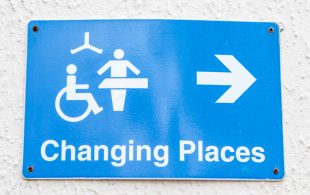How accessible are standard accessible toilets?
Did you know that standard accessible toilets do not always meet the additional needs of all disabled people? People with certain disabilities, including profound or multiple learning disabilities, spinal injuries and muscular dystrophy, find their needs are often not met in regular accessible toilets. They require extra equipment and more space to allow them, or their carers, to assist them in using the toilets safely and comfortably.
The Changing Places Consortium launched its campaign in 2006 to encourage businesses and public spaces to include Changing Places toilets in new builds, and to install them in existing buildings.
Where can you find Changing Places toilets?
Over a quarter of a million disabled people require Changing Places to allow them to get out and enjoy activities that people without these accessibility needs take for granted. The aim of the Changing Places Consortium is to enable disabled people to live a more fulfilling life, and allow them to use spaces and places previously inaccessible to them.
These include, but are not limited to:
- motorway service stations
- cinemas
- hospitals
- shopping centres and supermarkets
- airports
You can search for Changing Places on a map or use the journey planner function on the Changing Places website. There are now more than 1,550 Changing Places across the UK – up from 140 in 2007. This is a positive change, and more are needed to better support the estimated 250,000 severely disabled people dependent on them.
What does a Changing Places Toilet need to include?
Each Changing Places toilet provides the correct equipment, enough space, and a safe and clean environment. Without sufficient Changing Places, in addition to regular accessible toilets, the ability for some disabled people to travel or use public spaces is greatly reduced and can be difficult.
Equipment found in Changing Places includes:
- a height adjustable adult-sized changing bench
- a tracking hoist system, or mobile hoist
What makes Changing Places Accessible?
- enough space for a disabled person and two carers
- a centrally places toilet with room both sides for a wheelchair to maneuver
- a privacy screen or curtain
- a wide tear-off paper roll to cover the adult changing bench
- a large waste bin provided
- non-slip flooring
Did you know...
– The Queen Elizabeth Olympic Park was designed with Changing Places in several of its buildings, including cafe access.
– Nearly all Premier League football clubs now have Changing Places installed in their grounds.
– The National Trust has committed to building ten Changing Places at existing sites.
– Tesco recently installed its 100th Changing Places toilet
– There are mobile and modular Changing Places toilets available to hire for use at festivals, events and market towns.
The role of the Disability Unit in Changing Places toilets
The manager of a motorway service station reached out to the Minister for Disabled People, after a mother visiting the service station had struggled to change her disabled daughter without the appropriate facilities. The Minister agreed that more Changing Places needed to be installed across the country.
The Disability Unit has engaged across-government and with several sectors to increase awareness and encourage uptake of Changing Places. Disability and Access Ambassadors, (previously called Sector Champions), have also worked alongside the Disability Unit and industry sectors, resulting in uptake of Changing Places in shopping centres.
As a result of cross-government work and campaigning, the Government announced that Changing Places are to be compulsory for new buildings in England from 2021. There is a £30 million fund to install Changing Places in existing buildings. Public venues with a capacity of 350 or more people will have to install Changing Places if they are newly built or have a major refurbishment.
The Department for Transport, in partnership with Muscular Dystrophy UK, announced £2 million to install more Changing Places at motorway service areas across England. As a result, 87 of England’s 118 service stations will have a Changing Places toilet in the next few years.
The Ministry of Housing, Communities and Local Government have engaged in talks with architects about building regulations for Changing Places. They have also worked to increase the number of Changing Places in NHS hospitals to improve provision.
Join the conversation and follow us on Twitter @DisabilityUnit to keep up-to-date with what we’re doing.



3 comments
Comment by aboadam deme posted on
Thank you for this valuable information and I hope to see more of this information
Comment by Julie Csorba posted on
Thank you for looking into this and bringing it to the attention of others in this blog.
Comment by Chris Reeve posted on
If the installation of a Changing Place requires the removal of a standard wheelchair access wc, is this acceptable. I am thinking that usage time in a Changing Place may be considerably longer for a more severely disabled person and the removal of the standard unit is to some extent causing a problem for other wheel chair users. Could you enlighten me to best design practice,